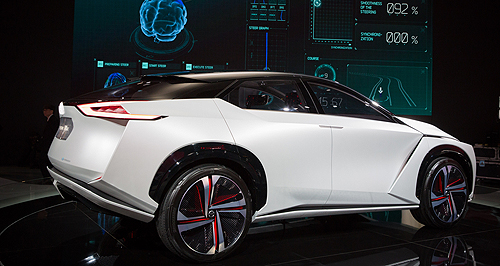Make / Model Search
News - NissanCES: Nissan B2V tech expected to make productionESP on: Although Nissan’s brain-to-vehicle technology can control a vehicle with a thought, its ability to control other in-cabin functions such as radio volume and temperature will make it even easier for drivers to interact with their cars. Controlling cars with brainpower part of Nissan’s ‘Intelligent Mobility’ strategy11 Jan 2018 By TUNG NGUYEN in LAS VEGAS NISSAN Motor Corporation will “absolutely” offer its forward-looking brain-to-vehicle (B2V) technology on production vehicles in future but rollout timing is still to be determined, according to executive vice-president of global marketing and sales Daniele Schillaci. Debuting at the Consumer Electronics Show (CES) in Las Vegas this week, the B2V system allows the driver to steer the car, accelerate and brake via a bespoke device that can read intended vehicle control inputs. Speaking to GoAuto at the show, Mr Schillaci, who is also in charge of Nissan’s zero-emission vehicles and battery business worldwide, said it is B2V’s ability to passively control other vehicle functions including drive mode, climate-control setting and seating position that will make it important to bring the technology to market. “The idea is absolutely one day to be capable to implement this in our vehicles, but I cannot tell you when,” he said. “The idea is always to bring this experience on the market for one simple reason: in order that the customer and the driver can benefit from this. “As always, technology is good if it makes your life better, if it doesn’t, okay, it is nice to have a good idea but in the end, it’s not so … interesting.” B2V works by interpreting the signal that is sent from your brain to your hands to tell it to move the steering wheel or apply acceleration or braking, with the system reportedly able to cut reaction time three tenths of a second faster than usual. Pairing with the brain-reading technology will be an artificial intelligence system that can read occupant discomfort and adjust auxiliary vehicle settings including media volume and suspension settings for a more comfortable ride. However, when asked if the technology could interrupt a signal incorrectly and turn unintendedly, Mr Schillaci said the vehicle’s suite of semi-autonomous technology would cut in and not allow a collision to take place. “This technology doesn’t guess what you want to do, otherwise it wouldn’t be too exceptional,” he said. “The technology doesn’t know if you want to go to McDonalds or if you want to stop to look at the sky or the mountains. “The technology just understands the timing of what is your next action … but the technology cannot guess what is the next action. “The technology through the timing … (can) anticipate that you want to turn, and then the ADAS (advanced driver assistance systems) starts to move the wheel half a second before you will do it yourself to make the turn at the best shape as possible, and to (make you) feel more comfortable.” Asked whether B2V technology would have a place in a world where fully autonomous vehicles will make driver inputs obsolete, Mr Schillaci said that Nissan vehicles will always have a steering wheel, even if it was one that could fold away into the dashboard. “Right now, we are focused on understanding the intention of the driver and how this technology can make their life better, anticipating the right shape of the curve or whatever,” he said. “The car can also work on the manual mode. So you have the manual mode and you have the full autonomous drive, but understand that this system is a system that is an experiment to understand what is the best interaction between the driver and the car.” Part of Nissan’s Intelligent Mobility plan, B2V technology falls into the integration ‘pillar’, next to electrified powertrains and autonomous technology as the other core elements. “This is extremely, let me say, consistent with Nissan Intelligent Mobility,” Mr Schillaci said. “Why? Because Nissan Intelligent Mobility, it’s mission is to move people to a better world through three pillars. “If you look at the Nissan Intelligent Mobility philosophy and strategy that aims to move people toward a better world, then you understand that the Nissan brain-to-vehicle technology makes sense, because this technology is meant really to make the customer driving experience better and smoother in the future than it is today.”  Read more |
Click to shareNissan articlesResearch Nissan Motor industry news |












Facebook Twitter Instagram